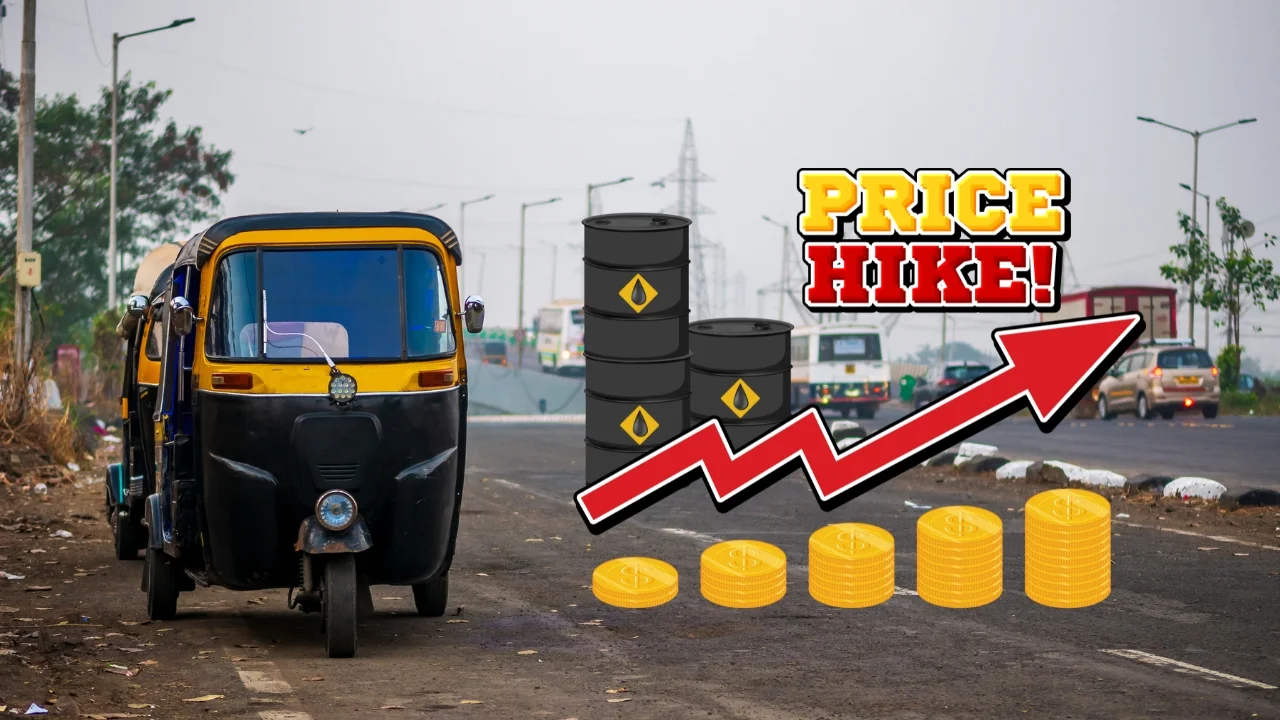Starting February 1, 2025, Mumbai commuters will have to pay higher fares for autorickshaws as the Mumbai Metropolitan Region Transport Authority (MMRTA) has announced a fare hike. The minimum fare for autorickshaws will increase from ₹23 to ₹26, impacting millions of daily passengers. This decision comes as part of an effort to adjust for rising operational costs, including fuel prices and vehicle maintenance. The rickshaw fare increases from 1st Feb 2025 in Mumbai will make commuting costlier for those who rely on autos for their daily travel.
Rickshaw Fare Increases from 1st Feb 2025 in Mumbai
| Vehicle Type | Old Minimum Fare | New Minimum Fare (Feb 1, 2025) | Per Kilometer Rate (Old) | Per Kilometer Rate (New) |
|---|---|---|---|---|
| Autorickshaw | ₹23 | ₹26 | ₹15.33 | ₹17.14 |
| Black-and-yellow Taxi | ₹28 | ₹31 | ₹18.66 | ₹20.66 |
| Blue-and-silver AC Cool Cab | ₹40 | ₹48 | ₹26.00 | ₹30.00 |
Apart from the base fare increase, the per-kilometer rate will also rise. Currently, autorickshaw passengers pay ₹15.33 per kilometer, but this will go up to ₹17.14 per kilometer. This means longer rides will become significantly more expensive. The fare hike comes at a time when many Mumbaikars are already dealing with increased living costs, making transportation an added burden. With rickshaw fare increases from 1st Feb 2025 in Mumbai, commuters will have to shell out more money for even the shortest rides.
This fare hike is not limited to rickshaws alone. Black-and-yellow taxis will also see an increase, with the base fare going up from ₹28 to ₹31. Additionally, AC Cool Cabs, known for their blue-and-silver design, will now charge ₹48 instead of ₹40 for the first 1.5 kilometers. However, the main concern for many daily commuters is the rickshaw fare increases from 1st Feb 2025 in Mumbai, as rickshaws remain one of the most commonly used transport modes in the city.
Expected Impact on Commuters
| Impact Area | Effect of Fare Hike |
|---|---|
| Commuting Costs | Increased travel expenses for daily commuters |
| Transport Alternatives | Possible shift to buses, trains, or two-wheelers |
| Traffic Congestion | More private vehicle usage leading to congestion |
| Public Transport Usage | Higher fares may push people to use Metro or buses more |
| Driver Reactions | Positive response as it helps cover operational costs |
Commuters are worried that the fare hike might force them to reconsider their daily travel options. Many office-goers, students, and senior citizens rely heavily on autos for short-distance travel. The rickshaw fare changes in Mumbai could push some people to look for alternative means of transport, including local trains, buses, or even two-wheelers, which might lead to increased congestion on the roads. Some fear that this could make traveling in Mumbai even more challenging.
Rickshaw drivers, on the other hand, argue that the fare hike is necessary to compensate for their rising operational costs. Many drivers say that fuel prices, maintenance expenses, and inflation have made it difficult for them to sustain their livelihoods. They believe the fare hike is a much-needed step, though they acknowledge that passengers may find it hard to adjust. The rickshaw fare increases from 1st Feb 2025 in Mumbai may help drivers cover their costs, but it remains to be seen how commuters will respond.
Fare Hike Trends in Indian Cities
| City | Recent Fare Hike | Reason for Hike |
|---|---|---|
| Mumbai | ₹23 to ₹26 for autos | Rising fuel and maintenance costs |
| Bengaluru | Proposed Metro fare hike (40-45%) | Inflation and operational costs |
| Pune | MSRTC bus fare increase | Higher fuel and operational expenses |
One major concern is whether the fare increase will lead to better services. Mumbaikars often complain about the behavior of some rickshaw drivers, including refusals to take short trips or overcharging passengers. With the rickshaw fare increases from 1st Feb 2025 in Mumbai, many passengers expect stricter regulations and better enforcement to ensure that drivers follow the rules. If fares are increasing, commuters argue, then service quality should improve too.
In response to concerns, the MMRTA has stated that efforts are being made to improve last-mile connectivity. New rickshaw and taxi stands are planned near Metro stations, which could make commuting more seamless. However, whether these changes will benefit passengers remains to be seen. For now, the immediate impact of the rickshaw fare increases from 1st Feb 2025 in Mumbai will be felt by those who have no choice but to pay more for their daily rides.
Mumbai is no stranger to fare hikes, as similar increases have occurred in the past. In 2021, there was a fare revision to accommodate rising costs, and now, just a few years later, another adjustment is being made. This trend is not limited to Mumbai alone. Other cities, such as Bengaluru and Pune, have also seen transport fare hikes recently. However, the rickshaw fare increases from 1st Feb 2025 in Mumbai are particularly concerning for those who depend on rickshaws as their primary mode of transport.
For many Mumbaikars, every rupee counts, and even a small increase in daily transport costs can add up over time. The impact will be felt most by middle-class and lower-income groups who cannot afford personal vehicles or expensive alternatives. The rickshaw fare increases from 1st Feb 2025 in Mumbai will force some people to rethink their travel habits, while others may simply have to bear the additional costs without any alternatives.
As the fare hike deadline approaches, commuters are left with mixed feelings. While some understand the need for an increase, others are frustrated by the added financial burden. Whether this move will lead to better services remains uncertain, but one thing is clear—rickshaw fare increases from 1st Feb 2025 in Mumbai will make commuting more expensive, and people will have to adjust accordingly.
